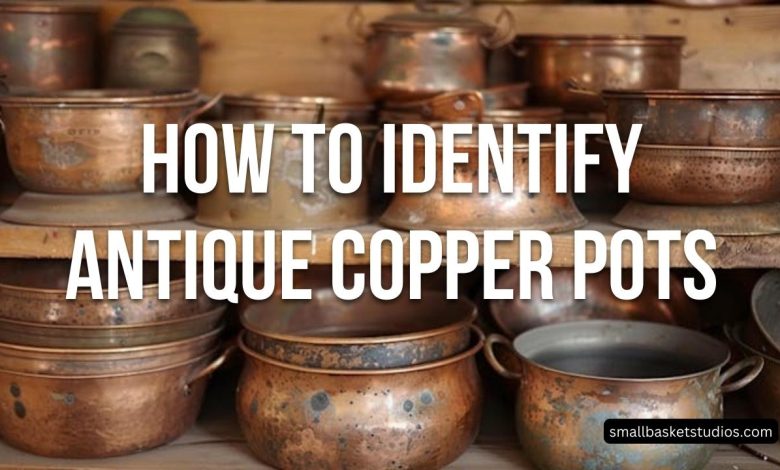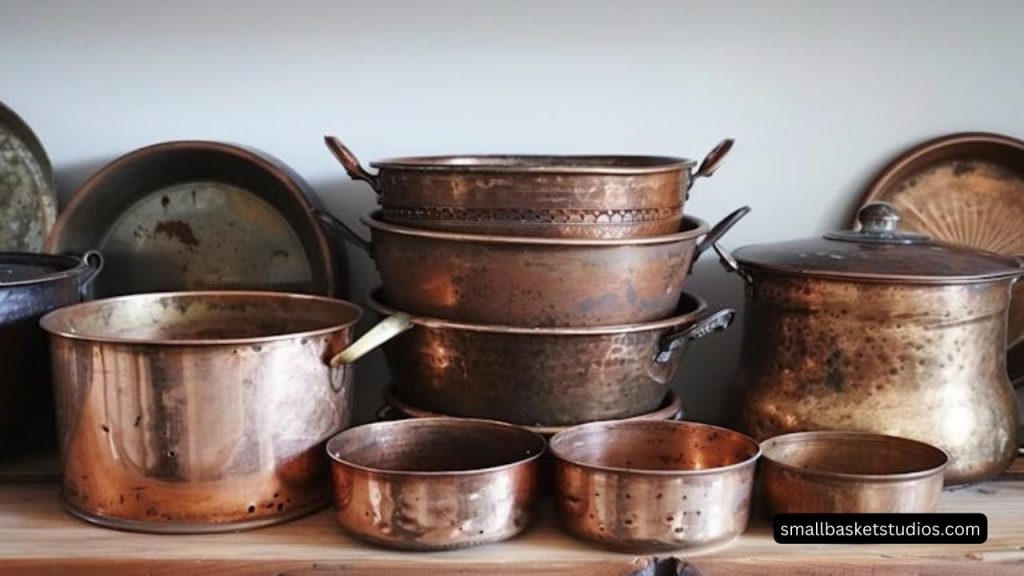How To Identify Antique Copper Pots?

In the realm of antiques, few objects captivate collectors and enthusiasts quite like antique copper pots. These timeless vessels, forged from the warmth of copper, have graced kitchens and homes for centuries, witnessing the evolution of culinary traditions and cultural heritage. Identifying genuine antique copper pots, however, requires a discerning eye and a deep understanding of their intricate craftsmanship, historical context, and unique characteristics.
This comprehensive guide delves into the fascinating world of antique copper pots, equipping you with the knowledge and expertise to distinguish authentic pieces from reproductions. Whether you’re a seasoned collector, a passionate historian, or simply an admirer of exquisite metalwork, this article will unveil the secrets to recognizing the true treasures that have withstood the test of time.
The Allure of Antique Copper Pots
Antique copper pots possess an undeniable charm that transcends their functional purpose. These vessels are not merely utilitarian objects; they are living remnants of our collective past, imbued with the stories and traditions of countless generations. Each pot bears the marks of its maker, the patina of age, and the warmth of countless meals prepared within its confines.

Copper’s unique properties, including its exceptional heat conductivity and natural antimicrobial qualities, made it the material of choice for culinary vessels throughout history. From the grand kitchens of noble households to the humble hearths of peasant homes, copper pots played a vital role in the preparation of nourishing meals and the preservation of cultural culinary traditions.
The Journey Through Time: Recognizing Antique Copper Pot Eras
To truly appreciate the value and significance of antique copper pots, it is essential to understand the historical context in which they were crafted. Each era brought forth distinct styles, techniques, and hallmarks that can aid in the identification process.
- The Renaissance Era (14th-17th Century) During the Renaissance, copper pots were highly prized for their durability and heat conductivity. These early vessels often featured intricate hammered patterns, embossed designs, and ornate riveted handles. The copper’s warm hue and lustrous finish made them sought-after pieces for affluent households.
- The Georgian Era (1714-1837) The Georgian period witnessed a surge in copper pot production, with artisans perfecting their craft and introducing new shapes and designs. These pots often featured flared rims, decorative handles, and elaborate surface textures. The quality and attention to detail during this era were unparalleled.
- The Victorian Era (1837-1901) Victorian copper pots were characterized by their refined elegance and intricate craftsmanship. Many were adorned with delicate engravings, embossed motifs, and ornamental handles. This era also saw the rise of specialized copper vessels, such as preserving pans and jelly moulds, reflecting the culinary trends of the time.
- The Early 20th Century (1900-1940) As industrialization took hold, copper pot production became more streamlined and utilitarian. However, skilled artisans continued to create exceptional pieces, often incorporating Art Nouveau and Art Deco influences into their designs. These pots showcased clean lines, geometric patterns, and a focus on functionality.
Deciphering the Maker’s Marks and Hallmarks
One of the most reliable ways to identify an antique copper pot’s origins and age is through the examination of maker’s marks and hallmarks. These unique stamps or engravings provide invaluable clues about the pot’s provenance, allowing you to trace its journey through time.
Maker’s marks often included the name or initials of the artisan or workshop responsible for crafting the pot. These marks can be found stamped, engraved, or embossed on the pot’s surface, typically near the rim or handle.
Hallmarks, on the other hand, were applied by assay offices or guilds to certify the quality and composition of the metal. These marks varied from region to region and can provide insights into the pot’s place of origin and the era in which it was produced.
By cross-referencing these marks with historical records and reference materials, you can unravel the rich tapestry of an antique copper pot’s heritage, adding depth and authenticity to your collection.
The Art of Patina: Unveiling the Secrets of Age
One of the most captivating aspects of antique copper pots is their patina – the unique and ever-evolving surface coloration that develops over time. This patina is a testament to the pot’s age and the countless hands that have touched it, imbuing it with a rich, lived-in character.
The patina’s hues can range from warm golden tones to rich, velvety browns, and even hints of verdant greens. Each shade and variation tells a story, reflecting the pot’s exposure to heat, moisture, and the elements throughout its lifetime.
Experienced collectors and experts can discern the authenticity of a patina by examining its depth, consistency, and overall appearance. A genuine patina will exhibit a natural, organic quality, with subtle variations and layers that cannot be replicated through artificial means.
However, it is essential to note that the presence of patina alone does not guarantee an antique copper pot’s authenticity. Careful examination of the pot’s construction, materials, and overall condition is necessary to make an informed assessment.
Craftsmanship and Construction: Hallmarks of Authenticity
Beyond the patina and maker’s marks, the craftsmanship and construction of an antique copper pot hold invaluable clues to its age and provenance. Skilled artisans of the past employed time-honored techniques and methods that are often challenging to replicate in modern times.
- Handcrafted Beauty Antique copper pots were meticulously crafted by hand, each one a unique work of art. Examine the pot’s form, proportions, and symmetry. Irregularities and slight variations in shape or thickness are hallmarks of handcrafted pieces, as opposed to the uniform consistency of mass-produced items.
- Riveted Handles and Joints The joining of handles, rims, and other components was often accomplished through traditional riveting techniques. Look for evidence of carefully placed rivets, each one expertly hammered and secured. Modern soldering or welding methods were not commonly used in the creation of authentic antique copper pots.
- Hammered and Embossed Details Many antique copper pots feature intricate hammered patterns, embossed designs, or engraved motifs. These decorative elements were painstakingly applied by skilled artisans, reflecting the cultural and artistic influences of their respective eras.
- Patina and Wear Patterns Genuine antique copper pots will exhibit natural wear patterns and patina consistent with their age and use. Look for areas of concentrated wear near handles, rims, and the bottom of the pot, where contact with heat sources and surfaces would have been most frequent.
By carefully examining these craftsmanship and construction details, you can separate genuine antique copper pots from modern reproductions, ensuring the authenticity and value of your collection.
Common Maker’s Marks and Hallmarks
| Maker’s Mark/Hallmark | Origin | Era |
|---|---|---|
| “GR” (Crowned) | England | Georgian |
| “EB” (Embossed) | France | 18th Century |
| “M” (Stamped) | Germany | Victorian |
| “DW” (Engraved) | United States | Early 20th Century |
Patina Color Guide
| Patina Color | Description | Typical Age |
|---|---|---|
| Golden Brown | Warm, rich tones | 50-100 years |
| Deep Reddish Brown | Velvety, intense hues | 100-200 years |
| Mottled Green | Verdigris formation | 200+ years |
| Multi-Colored | Layered, varied hues | Antique (Age varies) |
By combining your newfound knowledge with a deep appreciation for these remarkable artifacts, you can confidently navigate the world of antique copper pots, preserving their legacy for generations to come.
Conclusion:
Identifying authentic antique copper pots is a fascinating journey that requires a blend of knowledge, keen observation, and a deep appreciation for the craftsmanship and history that these vessels embody. By understanding the nuances of patina, maker’s marks, hallmarks, construction techniques, and historical context, you can unlock the secrets of these timeless treasures.
Remember, the true value of an antique copper pot extends beyond its monetary worth; it lies in its ability to transport us through time, connecting us with the traditions, cultures, and stories of generations past. Each pot is a living testament to the enduring human spirit, a reminder of our shared heritage, and a testament to the artistry that has withstood the test of time.
Frequently Asked Questions (FAQs)
How can I determine the age of an antique copper pot?
Determining the age of an antique copper pot involves examining various factors, such as maker’s marks, hallmarks, patina, construction techniques, and historical context. Cross-referencing these elements with reference materials and consulting with experts can provide a more accurate estimation of the pot’s age.
Are all antique copper pots valuable?
Not all antique copper pots are inherently valuable. The value is determined by various factors, including rarity, condition, provenance, and historical significance. However, even relatively common antique copper pots can hold sentimental value and serve as beautiful decorative pieces.
Can patina be artificially created or enhanced?
While it is possible to artificially create or enhance patina on copper using chemical treatments or accelerated aging processes, experienced collectors and experts can often distinguish genuine, naturally developed patina from artificial attempts.
How should antique copper pots be cleaned and maintained?
Antique copper pots should be cleaned and maintained with care to preserve their patina and integrity. Avoid harsh chemicals or abrasive cleaners, and opt for gentle cleaning methods using mild soap and water. Proper storage and handling are also crucial to prevent damage or excessive wear.
Are there any legal considerations when buying or selling antique copper pots?
When buying or selling antique copper pots, it is essential to research and comply with any relevant local, national, or international laws and regulations. Some jurisdictions may have specific regulations regarding the sale or export of certain antique or cultural items.



